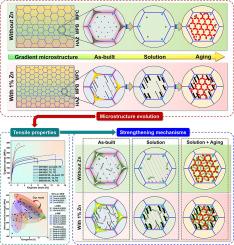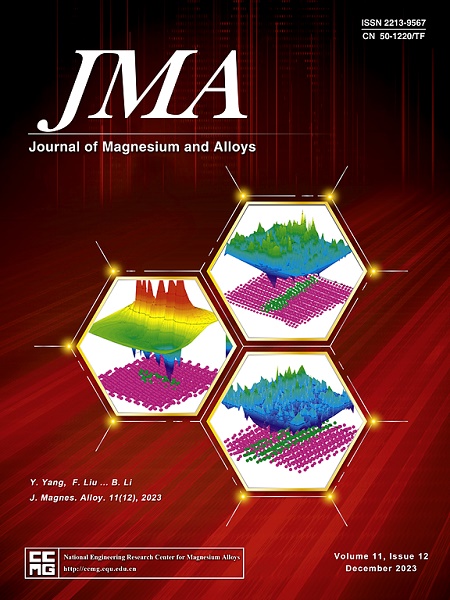The origin of ultrahigh-strength in GWZ1021K alloy fabricated by wire-arc directed energy deposition
IF 13.8
1区 材料科学
Q1 METALLURGY & METALLURGICAL ENGINEERING
引用次数: 0
Abstract
Research on the preparation of over-sized lightweight magnesium rare-earth (Mg-RE) components using the wire-arc directed energy deposition (WA-DED) is progressively gaining attention in the advanced manufacturing fields. Herein, to satisfy the demand of ultrahigh load-bearing, the Zn-modified Mg-10Gd-2Y-1Zn-0.5Zr (GWZ1021K) alloy was designed for exploring the influence pattern of Zn element on the microstructure and properties of Mg-10Gd-2Y-0.5Zr (GW102K) with high RE content. Specifically, the Zn element enables finer and more homogeneous grains in the as-built GWZ1021K (18.2 µm) than that in the as-built GW102K (23.9 µm), owing to more nucleation sites and precipitation of nano-γ" and nano-γ' to impede grain growth during the intrinsic heat treatment. After solution treatment, the eutectic phases and RE-rich regions completely disappear in both GW102K and GWZ1021K, yielding elongations of up to 14.6% and 13.2%, respectively. Notably, the high-temperature solution process allows the growth of nano-γ" and nano-γ', as well as the segregation of RE/Zn clusters and subsequent atomic rearrangements to form the 14H long period stacking ordered (LPSO) structures. Following peak-aging treatment, although dense nano-β' is precipitated in both GW102K and GWZ1021K, the Zn element facilitates the precipitation of nano-β1 to relieve the stress concentration induced by the two adjacent nano-β'. Generally, Zn elemental addition enhances strength with a sacrifice of ductility, which can be ascribed to the prismatic nano-β′ and basal 14H-LPSO structures work together to hinder the movement of both basal and non-basal dislocations. As a result, the GWZ1021K alloy achieves an ultra-high strength with an ultimate tensile strength of 403 MPa and a yield strength of 278 MPa, which far exceeds the reported average level of the WA-DED Mg-RE alloys. This study thus sheds new light on the fabrication of ultrahigh-strength Mg-RE alloy components by WA-DED process through appropriate composition modification.

线弧定向能沉积 GWZ1021K 合金超高强度的起源
利用线弧定向能沉积(WA-DED)技术制备超大型轻质镁稀土(Mg-RE)部件的研究在先进制造领域逐渐受到关注。为满足超高承载需求,本文设计了 Zn 改性 Mg-10Gd-2Y-1Zn-0.5Zr (GWZ1021K) 合金,以探索 Zn 元素对高稀土含量 Mg-10Gd-2Y-0.5Zr (GW102K) 显微结构和性能的影响模式。具体来说,由于在固有热处理过程中存在更多的成核点并析出纳米γ "和纳米γ',从而阻碍了晶粒的生长,因此与 GW102K(23.9 微米)相比,Zn 元素可使 GWZ1021K(18.2 微米)中的晶粒更细小、更均匀。经过固溶处理后,GW102K 和 GWZ1021K 中的共晶相和富含 RE 的区域完全消失,伸长率分别高达 14.6% 和 13.2%。值得注意的是,高温溶解过程允许纳米γ "和纳米γ'的生长,以及 RE/Zn 簇的分离和随后的原子重排,从而形成 14H 长周期堆积有序(LPSO)结构。经过峰值老化处理后,虽然 GW102K 和 GWZ1021K 中都析出了致密的纳米-β',但锌元素促进了纳米-β1 的析出,以缓解相邻两个纳米-β'引起的应力集中。一般来说,添加 Zn 元素可提高强度,但会牺牲延展性,这是因为棱柱形纳米-β′和基底 14H-LPSO 结构共同阻碍了基底和非基底位错的移动。因此,GWZ1021K 合金达到了超高强度,极限抗拉强度为 403 兆帕,屈服强度为 278 兆帕,远远超过了所报道的 WA-DED Mg-RE 合金的平均水平。因此,本研究为通过适当的成分改性采用 WA-DED 工艺制造超高强度 Mg-RE 合金部件提供了新的思路。
本文章由计算机程序翻译,如有差异,请以英文原文为准。
求助全文
约1分钟内获得全文
求助全文
来源期刊

Journal of Magnesium and Alloys
Engineering-Mechanics of Materials
CiteScore
20.20
自引率
14.80%
发文量
52
审稿时长
59 days
期刊介绍:
The Journal of Magnesium and Alloys serves as a global platform for both theoretical and experimental studies in magnesium science and engineering. It welcomes submissions investigating various scientific and engineering factors impacting the metallurgy, processing, microstructure, properties, and applications of magnesium and alloys. The journal covers all aspects of magnesium and alloy research, including raw materials, alloy casting, extrusion and deformation, corrosion and surface treatment, joining and machining, simulation and modeling, microstructure evolution and mechanical properties, new alloy development, magnesium-based composites, bio-materials and energy materials, applications, and recycling.
 求助内容:
求助内容: 应助结果提醒方式:
应助结果提醒方式:


